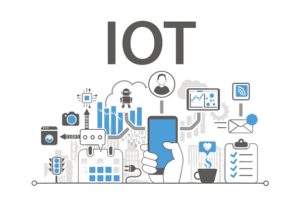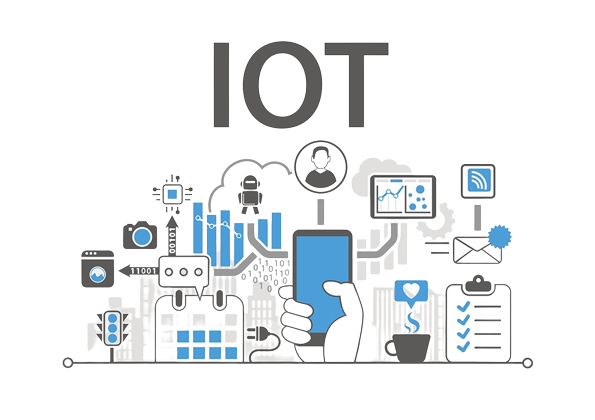To put it simply, the Internet of Things is a network of physical devices that are connected and communicate via the Internet. In many ways, the data that these Internet of Things devices collect and share with other devices, applications, and systems “talks” to us and the other things it is connected to.
To put it simply, the Internet of Things is a network of physical devices that are connected and communicate via the Internet. In many ways, the data that these Internet of Things devices collect and share with other devices, applications, and systems “talks” to us and the other things it is connected to.
Sensory, biotelemetry, and a plethora of other types of data are generated by IoT devices, which range from wearables to industrial sensors.

How does IoT work?
The Internet of Things (IoT) is a system of connected devices to the Internet. These minicomputer processors make use of machine learning to respond to sensor-collected data. Smart warehouse vehicles, fitness trackers, and temperature monitors for cold storage are all examples of IoT devices.
Four components make up an IoT system:
-
Sensors and devices
Smart or sensor-based devices transmit data to the cloud.
-
Data Collection & Connectivity
A connection is used to transfer data from a sensor or device to the cloud. How these devices connect varies according to their intended use.
Today, the most common methods are:
-
- HTTP/S
- Bluetooth
- RFID readers
- FTP
- And a host of new IoT communications protocols.
Data is transferred to a gathering point in a data center or the cloud using one of the aforementioned methods.
-
Data Processing and Machine Learning
After the Internet of Things, the device gathers information from its surroundings and stores it in a cloud or data center, software processes it. The device can decide to take action without the user’s input, such as sending an alert or automatically adjusting a sensor.
Numerous IoT devices can automatically adapt to user preferences as data is assembled. Some IoT products are smart devices because they use machine learning and data processing together. It is extremely useful that IoT devices can learn without programming.
Think of the smart thermostat, which automatically adjusts to the ideal indoor temperature, or the smart refrigerator, which not only notifies you when you run out of a particular grocery item but also orders one for you.
-
User Interface
Although automation is continuing to revolutionize how we interact with IoT devices, some decisions or actions require a conventional user interface to enable it. A user might want to use the same phone to check the IoT security camera they have installed in their house or adjust the temperature on a thermostat. An IoT user interface gives the user the ability to respond appropriately if user input or intervention is required.
Why is IoT important?
Simply put, the Internet of Things is a vast network of connected devices that is constantly expanding. Over 50 billion Internet of Things (IoT) devices is currently in use. Data is generated and exchanged with other connected devices or systems by this huge network of devices. The ability for consumers or businesses to access raw data, gain insight, and make intelligent decisions based on the story the data tells is essential to the IoT’s value.
The Internet of Things has numerous advantages, and more and more businesses are beginning to realize potential business applications. However, there are downsides and risks associated with the Internet of Things security and standards.
Smart TVs, automobiles, wearable exercise monitors, and even refrigerators are just a few examples of consumer-based Internet of Things (IoT) devices, but businesses are also utilizing security cameras, smart building infrastructure, connected electric meters, industrial control systems, GPS systems, and RFID chips, among other use cases.
Due to the abundance of wireless networks, it is now possible to connect just about anything, making it “smart,” and with data-generating sensors, creating a new intersection between the digital and physical worlds. Processors are more affordable than ever before.
What are the Major Concerns with the Internet of Things devices?
We have shown how useful the Internet of Things is, but there is also a downside that businesses need to be aware of.
-
Security in the Internet of Things (IoT)
Just like any other new technology, IoT presents an entirely new set of difficulties for businesses. There is still some confusion regarding IoT standards, policy, and governance for businesses. That are ready to incorporate some form of IoT into their organization. The number of connected devices in the Internet of Things (IoT) may a potential hindrance to its security viability, despite its promise. A security breach is more likely to occur the more devices there are. It’s concerning how many devices there are.
What is safe today may not always be safe tomorrow. And this is a major issue with IoT devices. As terrifying as that sounds, picture hackers being able to access or even control your wireless router, a smart car, a heart monitor, or even a pacemaker’s rhythm. One security flaw can compromise personal data privacy or compromise an organization’s security and hold the company hostage in an increasingly connected world.
-
Standards (or a lack thereof)
As the number of IoT devices has increased, numerous people have called for uniform standards to hold businesses accountable and get rid of unsecured devices and the security threat they pose. To fully secure IoT, providers, and manufacturers will need to increase their liability. When it comes to policies like sharing information, businesses must collaborate on their efforts.
Fun Facts about IoT
In just a few weeks, the Internet of Things (IoT)—whatever it is now—could look very different. Additionally, there is a wide range of uncertainty regarding IoT’s size and impact on business. After all, the scope of the impact that the Internet of Things is expected to have on society is always changing. Usually in terms of how much further that impact is estimated.
This is because IoT has always changed in tandem with other technologies. The Internet of Things (IoT) is expanding at the same rate as the cloud. As network capabilities increase, IoT expands. IoT expands with data analytics tools, and so forth.
LG introduced an internet-connected refrigerator in the early 2000s that was essentially a $20,000, 350-pound computer with limited capabilities. In 2020, Samsung’s smart fridge not only connects to an app with voice recognition to assist in ordering new items. But it also keeps track of the contents stored and expiration dates.
BACK










